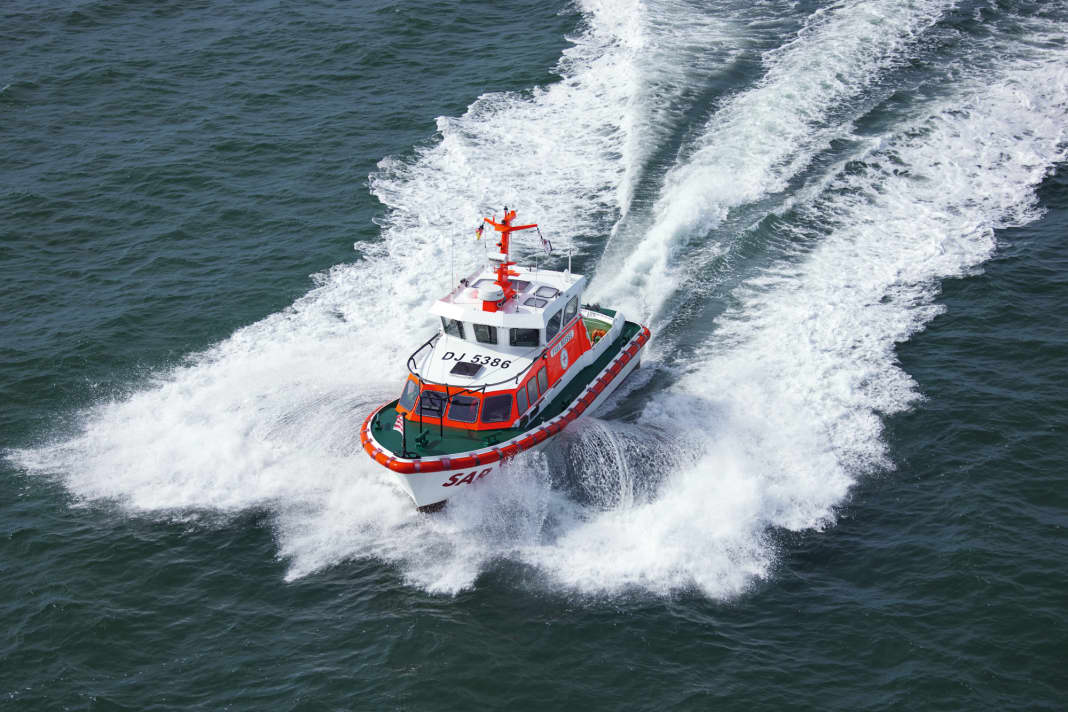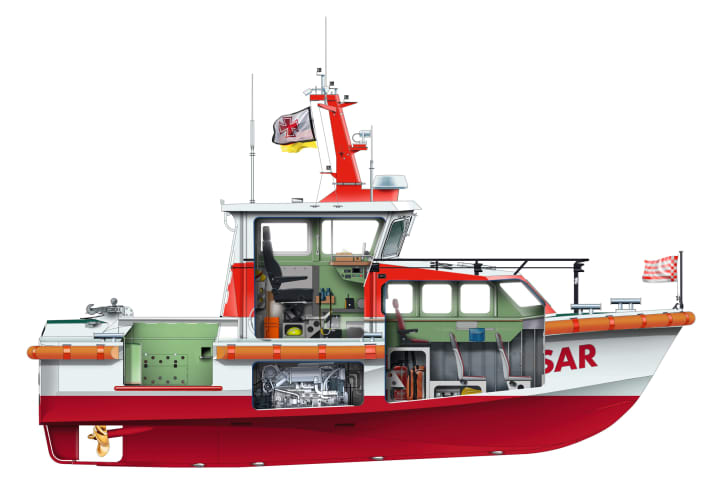





The 9.5/10.1 metre sea rescue boats of the German Maritime Search and Rescue Service (DGzRS) are deployed in almost all areas of the German North Sea and Baltic Sea. They are operated by volunteer crews. They live and work in the vicinity of their station, are at the harbour within a few minutes of being alerted, crew the boat and set off on their mission. Towards the end of the last millennium, the ageing DGzRS units were gradually replaced by a new, improved class. The new boats were only slightly larger than their predecessors, but were much more efficient thanks to the enormous advances in navigation and communication equipment. They were equipped with additional buoyancy chambers to right the boats after capsizing.
It all began in 1999 with the "Wilma Sikorski", the 9.5/10.1 metre class vessel. Building on the experience gained with the 8.5 metre class rescue boats, the DGzRS's foremen and designers developed the new type and equipped it with numerous improvements and further developments. The most striking feature is the delta shape of the hull, which ensures high stability and good seaworthiness with low resistance, especially when travelling offshore. The tried and tested principles of construction in the net rib system, made entirely of aluminium, have been retained. In contrast to its predecessors, however, the second, lower deck has been dispensed with, so that there is more space for accommodating casualties and providing medical care. The closed upper driver's cab is equipped with the latest navigation technology. The enlarged cockpit and the forward mast make it easier to work with helicopters when recovering casualties and the larger rescue door makes it easier to pick up people floating in the water ...
Sea rescue boat "Werner Kuntze"
... a detail that saved the life of a shipwrecked sailor in the Flensburg Fjord in November 2008. Just as Axel-Willy Bohn, third foreman of the Langballigau volunteer station, was about to lie down for a short afternoon nap, his mobile phone rang. "MRCC Bremen here. We have an assignment for you." Bohn is immediately wide awake, gets into his red overall and calls the rest of the crew. Minutes later, the 9.5 metre sea rescue boat "Werner Kuntze" is clear and heading out towards Holnis. From the south-west, a wall of black clouds pushes across the Flensburg Fjord. In a few moments, a hailstorm will break out, accompanied by lightning, thunder and heavy squalls. There is an uncomfortable south-westerly wind with gusts of around nine Beaufort and peaks of around 76 km/h. The navy's SAR helicopter, Sea King MK 2, is also en route to the scene of the accident. It has been alerted by MRCC BREMEN, as has all shipping in the area. This includes the water police and the fishing trawler "Mariechen", which is the first to arrive at the scene. The two-man crew of the wrecked dinghy pulled out all the stops: Mainsail recovered, foresail heavily reefed. But a gust of wind had hit the boat with devastating force and capsized it. Now it is drifting keel-up in the choppy sea. The sailors try to save themselves on the hull and cling to the keel. Miraculously, a walker on land observes the drama and alerts the control centre.
When the "Werner Kuntze" arrives, the cutter already has the sailor on board. The 70-year-old man is still adrift in the eight-degree Baltic Sea. Without hesitation, rescue man Oliver Bohn slips on the water- and cold-protective survival suit and jumps into the icy sea. He later reports: "When we were close enough, we could see a person clinging to a rope of the capsized dinghy. We kept a good 15 metres away. The sea was too choppy and it was too dangerous to get any closer." The sea rescuer bravely grabs the sailor, who is in shock, and tows him to the open rescue harbour with powerful swimming strokes. Meanwhile, his colleague converts the lounge of the rescue boat into an on-board hospital. In the language of the seamen, this means: warm blankets, dry clothes, oxygen. Once the man is on board, the crew takes the woman from the cutter and then it's "full speed ahead" to Minde. Less than 45 minutes after the alarm, the operation is completed. Paramedics and an emergency doctor take over the shipwrecked sailor. The man is taken to hospital with a body temperature of just 30 degrees. He will survive. Thanks to the quick and courageous efforts of the volunteer crew from Langballigau.
Sea rescue boat "Kurt Hoffmann"
In many cases, it is only thanks to the good cooperation of several rescue units and the attention and intervention of third parties on site that people can be saved. This was also the case in September 2016, when a motorboat rammed an unknown object in the water around ten nautical miles north-west of Rügen and suffered severe water ingress. The skipper only had a few minutes to make a "Mayday" call on the VHF radio before saving himself on his life raft. The Maritime Rescue Coordination Centre in Bremen alerts the rescue cruiser "Harro Koebke" in Sassnitz and the crew of the rescue boat "Kurt Hoffmann" from the Glowe station on the north coast of Rügen, as well as the surrounding shipping and a DRF Luftrettung helicopter. Working closely together, the rescue units and a wind farm supply vessel, which is the first on the scene, succeed in rescuing the man and recovering the stricken boat. The volunteer sea rescuers go alongside with the "Kurt Hoffmann" and manage to pump the boat empty with mobile pumps to such an extent that the massive damage to the bow can be identified as the cause of the water ingress. It is impossible to tow the boat in, it would sink. The multi-purpose vessel "Arkona" then takes the damaged vessel on deck with its onboard crane.
Here you can find the second and third part of the sea rescue report:
About the sea rescuers of the German Maritime Search and Rescue Service (DGzRS)

In the vast majority of cases, the names of the SRBs come from the sponsors whose donations or bequests made their construction possible. The "Wilma Sikorski", built in 1999, is the type boat of the 9.5 metre class, of which - together with the slightly larger 10.1 metre class - 34 units are currently in service. The youngest of these, the "Courage", was commissioned in Neuharlingersiel in 2023. Like all DGzRS units, they are designed as self-righting vessels and are equipped with state-of-the-art navigation and communication technology. Speed: 18 knots; range at 17 knots: approx. 240 nm.
- 55 stations between Borkum in the west and Usedom in the east
- Around 20 rescue cruisers and 40 rescue boats
- 1000 sea rescuers, including more than 800 volunteers
- Ready for use in any weather, around the clock
- Around 2000 missions on the North Sea and Baltic Sea every year
- Coordinated by the German Maritime Rescue Coordination Centre in Bremen, which is operated by the DGzRS
- More than 86,000 people rescued since its foundation in 1865
- financed exclusively by voluntary contributions, without taxpayers' money
- more information: www.seenotretter.de, e-mail: info@seenotretter.de

